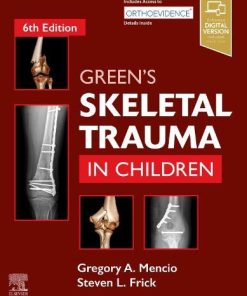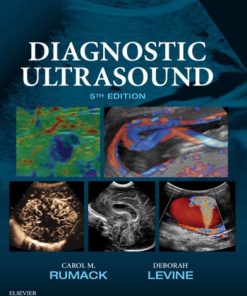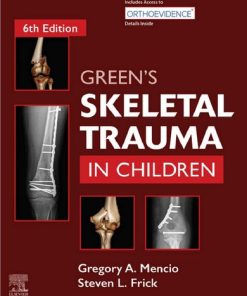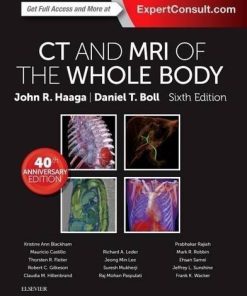Skeletal Trauma Basic Science Management and Reconstruction 2 Volume Set 6th Edition by Bruce Browner, Jesse Jupiter, Christian Krettek, Paul Anderson 0323611168 9780323611169
$50.00 Original price was: $50.00.$25.00Current price is: $25.00.
Skeletal Trauma: Basic Science, Management, and Reconstruction, 2-Volume Set 6th Edition by Bruce D. Browner, Jesse B. Jupiter, Christian Krettek, Paul A Anderson 0323611168 9780323611169 – Ebook PDF Instant Download/DeliveryISBN:
Full download Skeletal Trauma: Basic Science, Management, and Reconstruction, 2-Volume Set 6th Edition after payment.
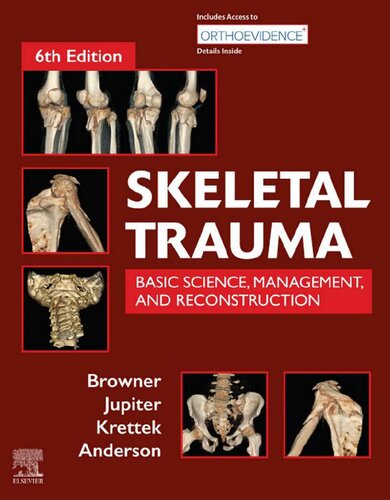
Product details:
ISBN-10 : 0323611168
ISBN-13 : 9780323611169
Author : Bruce D. Browner, Jesse B. Jupiter, Christian Krettek, Paul A Anderson
Skeletal Trauma
Skeletal Trauma: Basic Science, Management, and Reconstruction, 2-Volume Set 6th Table of contents:
1 The History of Trauma Care
Introduction
The Ancient World
The Middle Ages
The Early Modern Era (ca. 1450–ca. 1800)
Trauma Management in the 19th Century
Trauma Management in the 20th Century
War on Terror
Conclusion
References
2 Global Burden of Musculoskeletal Injuries
Causes of Injury
Geographic and Demographic Distribution of Injury Burden
Estimating the Burden of Musculoskeletal Injury
Focus on Military Injuries
References
3 The Challenges of Orthopaedic Trauma Care in the Developing World
Introduction
Improving Trauma Care Systemwide Globally: the World Health Organization’s Guidelines for Trauma System Development
The Role of the WHO: the World Health Assembly Resolutions on Trauma and Emergency Care Services and on Essential Surgical Care
Barriers to Access
Education
Pediatric Trauma (Management of Common Injuries)
Adult Trauma
Amputations
Avenues for Orthopaedic Volunteerism
The SIGN Intramedullary Nail System
References
4 Vascularity and Stability
Introduction
Strain and Vascularity
“Teams” Of Cells Provide Solutions
Two Methods of Ossification
Vascularity in Healing Fractures
Fracture Fixation
Conclusion
References
5 Biology and Enhancement of Skeletal Repair
Introduction
Biology of Graft Substitutes
Autogenous Iliac Crest Bone Graft
Osteoconductive Graft Substitutes
Demineralized Bone Matrix
Patient-Derived Cellular Therapies
Inductive Substrates (Bone Morphogenetic Proteins)
Conclusion
References
6 Biomechanics of Fractures
Introduction
Basics of Mechanics
Bone Properties and Fracture Risk
Structural Properties and Loading Modes
Fracture Healing
Summary
References
7 Closed Fracture Management
Introduction
Basic Principles
Scaphoid Fractures
Distal Radius Fractures
Humeral Shaft Fractures
Proximal Humerus Fractures
Ankle Fracture
Tibial Fractures
Traction
References
8 Principles and Complications of External Skeletal Fixation
Historical Background
Fixator Terminology
Problems, Obstacles, and Complications
Nerve and Vessel Injury
Implant Placement to Avoid Neurovascular Injury
Pin Tract Infection
Fixator-Associated Problems
Pain
Principles Unique to the Ilizarov Method
External Fixators as Nonunion Machines
External Fixators for Damage Control Orthopaedics
References
9 Principles of Internal Fixation
Introduction
Plan of Attack and How to Use This Chapter
Fracture Pattern
Soft Tissue Pattern
Area Involved
Desired Stability
Approach
Reduction: Direct Versus Indirect
Fixation
Steps of Intramedullary Rodding
Construct Stability
Construct Failure
Preoperative Planning
Summary
References
10 Evaluation and Treatment of the Multi-Injured Trauma Patient
Introduction
Trauma Systems
Prehospital Evaluation and Care
Hospital Evaluation and Care
The Future of Trauma Care
Summary
References
11 Initial Evaluation of the Spine in Trauma Patients
Introduction
Initial Evaluation and Stabilization
Advanced Trauma Life Support
Classification of Neurologic Injury
Radiographic Assessment
Cervical Spine Clearance
Thoracolumbar Spine Clearance
Geriatric Spine Trauma
Conclusion
Acknowledgment
References
12 Damage Control Orthopaedic Surgery: A Strategy for the Orthopaedic Care of the Critically Injured Patient
Introduction
History
Initial Treatment of the Multiply Injured Patient
Clinical Experience
Conclusion
References
13 Disaster Management
Introduction
Disaster Planning
Disaster Classification
Disaster Management
Natural and Manmade Disasters
Medical Management of Disaster Casualties
Disaster Education Initiatives
Summary
References
14 The Management of Acute and Perioperative Pain Associated With Trauma and Surgery
Introduction
Physiology of Pain
Assessment of Acute Pain
Treatment of Acute Pain
Controversial Issues in Acute Pain Medicine
Some Practical Considerations for Collaboration Between Orthopaedic Surgeons and Acute and Chronic Pain Specialists
Conclusion
Acknowledgments
References
15 Chronic Pain Management
Introduction
Chronification of Pain After Trauma
Complex Regional Pain Syndrome
Neuromodulation for Chronic Pain After Trauma
References
16 Evaluation and Treatment of Vascular Injuries
Introduction
Epidemiology and Outcomes of Vascular Injury in Orthopaedic Trauma
History and Physical Examination
Diagnosis
Nonoperative Management
Management of Vascular Injury
Postoperative Care
References
17 Compartment Syndromes
Introduction
History
Pathophysiology
Diagnosis: Clinical Assessment
Crush Syndrome
Compartment Syndrome in Combat
Measurement Techniques
New Technologies
Fasciotomy Techniques
Chronic Exertional Compartment Syndrome
Future Direction
Acknowledgments
References
18 Open Fractures
Introduction
Mechanism
Pathophysiology: Infection
Classification
Basic Principles of Open Fracture Management in the Emergent Setting
Basic Principles of Open Fracture Management in the Operating Suite
Open Fractures With Compartmental Syndrome
Osseous Stabilization
Wound Management
Future Developments
Conclusion
References
19 Soft Tissue Reconstruction
Introduction and General Principles
Wound Preparation for Soft Tissue Coverage
Negative-Pressure Wound Therapy
Wound Coverage Types
Soft Tissue Reconstruction of the Upper Extremity
Lower Extremity Soft Tissue Reconstruction
Rehabilitation and Outcomes
References
20 Gunshot Wounds and Blast Injuries
Introduction
Ballistics
Diagnosis
General Treatment Principles
Upper Extremity
Lower Extremity
Orthopaedic Management in the Blast Trauma Patient
References
21 Pathologic Fractures
Introduction
Metastatic Bone Lesions
Evaluation
Diagnosis
Management
Complications
Special Considerations
Conclusion
References
22 Osteoporotic Fragility Fractures
Demographics of Osteoporotic Fragility Fractures
Trends of Fragility Fractures
Results of Fragility Fractures
Socioeconomic Implications of Fragility Fractures
Is the Medical System Prepared for This Change?
Secondary Fracture Prevention: Dietary Supplementations and Medical Therapies
Prevention of Falls
Medical and Surgical Interventions
Summary
References
23 Surgical Site Infection Prevention
Introduction
Defining Surgical Site Infections
Preoperative Interventions
Prophylactic Antibiotics
Intraoperative Means of Reducing Infection
Conclusion
References
24 Diagnosis and Treatment of Complications
Systemic Complications
Local Complications of Fractures
Management of Complications
Risk Management
Summary
References
25 Understanding and Treating Chronic Osteomyelitis
History
Epidemiology
Pathogenesis
Types and Classification of Osteomyelitis
Diagnostics
Planning and Treatment of Chronic Osteomyelitis
Role of Systemic Antibiotics in the Treatment of Chronic Osteomyelitis
References
26 Nonunions
Introduction
Definitions
Fracture Repair
Etiology of Nonunions
Evaluation of Nonunions
Treatment
Summary
Acknowledgments
References
27 Motorized Intramedullary Lengthening Nail for Limb Reconstruction
Introduction
Fundamental Principles
Antegrade Femur Lengthening
Retrograde Femur Lengthening
Tibial Lengthening
Nonunion Compression
Outcomes
Summary
References
28 Psychological, Social, and Functional Manifestations of Orthopaedic Trauma and Traumatic Brain Injury*
Introduction
Biomedical Versus Biopsychosocial Model of Medicine
Anxiety Disorders and Posttraumatic Stress
Traumatic Brain Injury and Posttraumatic Stress Disorder
Traumatic Brain Injury and Suicide
Depression
Impact of Psychological Comorbidities on Disability and Family Function
Prevention and Management of Psychological Comorbidities
Communication, Education, and Resources
Conclusion and Future Directions
References
Section Two Spine
Introduction
29 Pathophysiology and Early Management of Spinal Cord Injury
Introduction
Pathophysiology of Spinal Cord Injury
Concepts of Neuroprotection
Principles of Early Management
Conclusion
References
30 Craniocervical Injuries
Introduction
Anatomy of the Craniocervical Junction
Physical Examination
Diagnostic Imaging
Craniocervical Dissociations
Occipital Condyle Fracture
Atlas Fractures and Transverse Atlantal Ligament Injuries
Atlantoaxial Injuries
Surgical Fixation of Craniocervical Injuries
Conclusion
References
31 Craniocervical Injuries
Introduction
Mechanism of Injury, Biomechanics, and Anatomy
Evaluation
Diagnosis and Classification
Management
Meta-Analyses and Systematic Reviews
Guidelines
Cost-Effectiveness
Conclusion
References
32 Subaxial Cervical Spine Trauma
Introduction
Anatomy
Biomechanics
Classification Systems
Aospine Subaxial Cervical Spine Injury Classification System
Management
Techniques
Summary
References
33 Thoracolumbar Trauma
Classification
Treatment of Burst Fractures
Flexion-Distraction and Fracture-Dislocation Injuries
Low-Lumbar Fractures
New Concepts in Management of Thoracolumbar Fractures
References
34 Fractures in the Ankylosed Spine
Introduction
Global Epidemiologic Trends in Ankylotic Spinal Disorders
Biomechanical Modifications and Altered Fracture Mechanisms of the Ankylosed Spine
Prehospital Care for Patients With Fractures of the Ankylosed Spine
In-Hospital Diagnosis and Classification of Fractures of the Ankylosed Spine
Considerations for the Optimal Treatment of Ankylosed Spine Fractures
Long-Term Outcome and Possible Ways to Improve Care
References
35 Osteoporotic Spinal Fractures
Introduction
Epidemiology
Evaluation
Diagnosis and Classification
Management
Surgical Intervention
Complications
Clinical Outcomes
Cost-Effectiveness
Conclusion
References
36 Avoiding Complications in Spine Trauma Patients
Introduction
Preoperative Considerations
Intraoperative Management
Postoperative Considerations
Conclusion
References
37 Principles of Orthotic Management
Introduction
Cervical Orthoses
Thoracolumbar Orthoses
Other Types of Special Orthoses
Illustrative Case: Hangman’s Fracture
General Principles of Orthotic Use
Outcome of Bracing After Spinal Trauma
Complications of Bracing
Summary
References
Section Three Pelvis
Introduction
38 Pelvic Ring Injuries
Introduction
Anatomy
Pelvic Stability and Biomechanics
Trauma Mechanism and Pathomechanics of Pelvic Injuries
Radiologic Diagnostics in Pelvic Injuries
Classification of Pelvic Injuries
Acute Management
Emergency Management
Definitive Management
Conservative Treatment of Pelvic Ring Fractures
Postoperative Treatment
Complications
Genitourinary Injuries
Open Pelvic Fractures
Outcome
References
39 Surgical Treatment of Acetabular Fractures
Epidemiology
Osteology
Radiology
Classification
Decision Making
Operative Timing
Initial Management
Surgical Exposures
Manipulative Reduction and Percutaneous Fixation
Exposure, Reduction, and Fixation by Fracture Pattern
Aftercare
Complications
Summary
References
Section Four Upper Extremity
Introduction
40 Fractures and Dislocations of the Hand
The Thumb Ray
Intraarticular Carpometacarpal Fractures of the Thumb Metacarpal
Extraarticular Fractures of the Thumb Metacarpal
Ligamentous Injuries
Metacarpal Fractures (Excluding the Thumb)
Metacarpophalangeal Joint Ligamentous Injuries
Phalangeal Fractures and Interphalangeal Joint Injuries
References
41 Fractures and Dislocations of the Carpus
Fractures of the Scaphoid
Other Carpal Fractures
Dislocation of the Carpus
References
42 Fractures of the Distal Radius
Functional Anatomy
Classification
Diagnostic Imaging
Determination of Stability
Relation of Anatomy to Function
Treatment
Treatment of Intraarticular Fractures
Associated Injuries
Complications
Evaluation of Outcome
Future Considerations
Summary
References
43 Diaphyseal Fractures of the Forearm
Functional Anatomy
Classification of Diaphyseal Forearm Fractures
Diagnosis
Treatment
Aggravating Cofactors
Complications
Outcome
Conclusion
References
44 Trauma to the Adult Elbow
Introduction
Mechanism of Injury and Biomechanics
Evaluation
Diagnosis and Classification
Management
Meta-Analyses and Systematic Reviews
Conclusion
References
45 Fractures of the Distal Humerus
Introduction
Epidemiology
Functional Anatomy
Surgical Anatomy
Blood Supply
Evaluation
Classification
Management
Complications
Outcome
Meta-Analyses and Systematic Reviews
Conclusion
References
46 Fractures of the Humeral Shaft
Introduction
Mechanism of Injury/Biomechanics
Evaluation
Diagnosis and Classification
Management
Complications
Outcome
Meta-Analyses and Systematic Reviews
Guidelines
Cost-Effectiveness
Conclusion
References
47 Proximal Humeral Fractures and Glenohumeral Dislocations
Essential Principles for Treatment of Proximal Humeral Fractures and Glenohumeral Dislocations
Proximal Humeral Fractures and Fracture-Dislocations
Glenohumeral Dislocations
Treatment of Fracture Sequelae of the Proximal Humerus
References
48 Fractures and Dislocations of the Clavicle
Anatomy
Sternoclavicular Joint Dislocation
Shoulder Suspensory Complex
Acromioclavicular Joint Dislocation
Fractures of the Clavicle
References
49 Scapula Fractures
Introduction
Mechanism of Injury and Biomechanics
Evaluation
Diagnosis and Classification
Management of Scapula Fracture
Complications
Outcome
Meta-Analyses and Systematic Reviews
Conclusion
References
50 Chest Wall Trauma
Introduction
Rib Fractures
Sternum Fractures
References
51 Replantation
Introduction
Indications and Contraindications
Preoperative Evaluation and Transport
Preoperative Considerations
Management
Expectations After Replantation
Special Circumstances
References
Section Five Lower Extremity
Introduction
52 Hip Dislocations
Introduction
Pathology
Diagnosis
Treatment
Outcomes
Conclusion
References
53 Medical Management of the Patient With Hip Fracture
Outcome Variables
Preoperative Assessment
Perioperative Management
Osteoporosis
Summary
References
54 Intracapsular Hip Fractures
Femoral Head Fractures
Femoral Neck Fractures
References
55 Intertrochanteric Hip Fractures
Introduction
Incidence and Epidemiology
Anatomy of the Intertrochanteric Region
Diagnosis
Classification of Intertrochanteric Femur Fractures
Management
Complications
Patient Outcome
Summary
References
56 Posttraumatic Reconstruction of the Hip Joint
Primary Reconstruction
Reconstruction After Failed Internal Fixation
Conclusion
References
57 Subtrochanteric Fractures of the Femur
Anatomy
Biomechanics
Incidence and Mechanism of Injury
Physical Examination
Radiographic Studies
Classification
Management
Complications
Acknowledgments
References
58 Femoral Shaft Fractures
Introduction
Epidemiology
Anatomic Considerations
Pathophysiology: Polytrauma Considerations
Patient Assessment and Initial Management
Fracture Classification
Principles of Management of Diaphyseal Femoral Fractures
Special Situations
Bone Loss and Nonunion in Femoral Fractures
Hardware Failure
Summary
References
59 Fractures of the Distal Femur
Pathology
Diagnosis
Treatment
Complications
References
60 Patella Fractures and Extensor Mechanism Injuries
Anatomy
Biomechanics
Patient’s History and Physical Examination
Radiographic Evaluation
Injuries
Acknowledgment
References
61 Dislocations and Soft Tissue Injuries of the Knee
Pathology
Diagnosis
Treatment
Complications
References
62 Tibial Plateau Fractures
Introduction
Biomechanics and Mechanism of Injury
Evaluation and Examination
Fracture Management
Complications
Outcomes
Conclusion
References
63 Malunions and Nonunions About the Knee
Introduction
General Principles
Nonunion Classification
Intraarticular Versus Extraarticular Osteotomies
Limb Length Discrepancy
Charcot Neuroarthropathy
Surgical Considerations
Distraction Osteogenesis
Internal Versus External Fixation
Monolateral Versus Circular External Fixation
Arthroscopy-Assisted Surgery
Fixator-Assisted Surgery
Total Knee Replacement After Trauma
Authors’ Preferred Treatment Method
References
64 Tibial Shaft Fractures
Introduction
Relevant Surgical Anatomy
Mechanism of Injury and Biomechanics
Diagnosis
Management
Complications
Outcomes of Tibia Shaft Fractures
Cost-Effectiveness
Acknowledgment
References
65 Fractures of the Tibial Pilon
Mechanism of Injury
Classification
Radiographic Evaluation
Initial Treatment
Plate Fixation
External Fixation
Tensioned-Wire Technique
Wound Closure
Open Fractures
Flap Coverage
Postoperative Care
Obesity and Diabetes
Nonreconstructible Pilon Fractures
Complications
Clinical Outcomes
Prognosis
Summary
References
66 Malleolar Fractures and Soft Tissue Injuries of the Ankle
Introduction
Anatomy and Biomechanics
Patient Presentation, History, and Physical Examination
Radiographic Imaging
Classification
Initial and Definitive Management of Ankle Fractures
Fractures in Special Treatment Groups
Management of Soft Tissue Injuries: Syndesmosis and Deltoid Ligaments
Acknowledgments
References
67 Foot Injuries
General Principles of Care
Evaluation and Initial Management
Fractures of the Talus
Tarsal Dislocations
Calcaneal Fractures
Navicular Fractures
Tarsometatarsal (Lisfranc) Injuries
Cuboid Fractures
Cuneiform Fractures
Metatarsal Fractures
Injury to the Metatarsophalangeal Joints
Injury to the Proximal Phalanx and Interphalangeal Joint of the Hallux
Injury to the Lesser Phalanges and Interphalangeal Joints
Distal Phalanx and Nail Bed Injuries
Sesamoid Fractures
Foot Compartment Syndrome
Mutilating Injuries: the Mangled Foot
Thermal Injury
Gunshot Wounds
Heel Pad Injury
Traumatic Tendon Injury
Puncture Wounds
Neuropathic Foot Fracture
Advanced Imaging Modalities for Foot Trauma
Acknowledgment
References
68 Posttraumatic Reconstruction of the Foot and Ankle
Principles of Reconstructive Surgery of the Foot and Ankle
Physical Examination
Imaging Studies
Ankle and Pilon Malunions and Nonunions
Surgical Treatment of End-Stage Ankle Arthrosis
Talar Malunion and Nonunion
Calcaneal Malunion and Nonunion
Chopart Joint Malunions and Nonunions
Lisfranc Joint Malunion and Instability
Metatarsal Nonunions and Malunions
Phalangeal Malunions and Nonunions
Sesamoid Nonunion and Necrosis
Soft Tissue Balancing: Tendon Lengthening and Transfer
References
69 Periprosthetic Fractures of the Lower Extremity
Introduction
Epidemiology
Risk Factors
Diagnostics
Classification
Management
Outcome and Complications
Periprosthetic Fractures Around Unicompartmental Knee Arthroplasty
Interprosthetic Femoral Fractures
Management of Femoral Nonunion
Prevention of Periprosthetic Fractures
References
70 Principles of Deformity Correction
Lower Limb Alignment and Joint Orientation
Characteristics of Deformity
Osteotomy Rules
Focal Dome Osteotomy
Joint Considerations for Correction of Deformity
Improvements in Deformity Correction: Development and Application
References
71 Limb Salvage and Reconstruction
Do the Limbs Matter?
Why so Many Extremity Injuries?
Initial Management: Think Physiology, Not Anatomy
Common Factors Addressed With Initial Decision Making
Limb Salvage: Surgical Reconstruction
Rehabilitation
Costs
Outcomes
References
72 Amputations in Trauma
General Principles
Upper Extremity Amputations
Lower Extremity Amputations
Special Considerations
General Prosthetic Considerations and Rehabilitation
Future Directions
Complications
References
73 Articular Cartilage Reconstruction Using Osteochondral Allografts
Introduction
Free Allogenic Osteochondral Transplants
Challenges of and Obstacles to the Use of Fresh Osteochondral Allograft
Diagnosis
Indications
Surgical Planning
Transplantation Techniques
Additional Pathologies
Rehabilitation
Complications
Conclusion
References
Section Six Legacy Chapters
Introduction
74 The History of Fracture Treatment
Early Splinting Techniques
Precursors of the Plaster Bandage
The Plaster Bandage and Its Derivatives
Traction
Functional Bracing
Open Fractures
Early Fracture Surgery
External Fixation
Intramedullary Fixation
Robert Danis and the Development of the AO Group
Gavriil A. Ilizarov and the Discovery of Distraction Osteogenesis
Emile Letournel and the Surgery of Pelvic and Acetabular Fractures
Klaus Klemm and Interlocking Nailing and Local Antibiotic Bead Chain Therapy
Maurice Edmond Müller, Internal Fixation Techniques and Hip Prostheses
Martin Allgöwer, Internal Fixation and Fracture Management
Summary
References
75 Occupational Hazards in the Treatment of Orthopaedic Trauma
Optimal and Safe Use of C-Arm X-Ray Fluoroscopy Units
Prevention of Occupationally Acquired Bloodborne Pathogens
Summary
References
76 Medical Management of the Orthopaedic Trauma Patient
Acute Pain Management, Regional Anesthesia Techniques, and Management of Complex Regional Pain Syndrome
Treatment Options
Assessment
Pharmacotherapy
Diagnosis and Differential
Initiation and Assessment of Therapy
Complex Regional Pain Syndrome
Perioperative Assessment
Pulmonary Risk Assessment
Medications
Ordering Tests
Diabetes Mellitus
Obstructive Sleep Apnea
Liver Disease
Preventing Complications
Management of the Pregnant Woman
Substance Abuse Syndromes: Recognition, Prevention, and Treatment
References
77 Surgical Site Infection Prevention
Defining Surgical Site Infections
Preoperative Interventions
Prophylactic Antibiotics
Intraoperative Means of Reducing Infection
Conclusion
References
78 Physical Impairment Ratings for Fractures
Generic Issues of Disability and Impairment
Types of Disability
Epidemiology of Fractures in the United States
Guides for Impairment Determination
Preexisting Conditions and Apportionment
Summary
References
79 Outcome Assessment in Orthopaedic Traumatology
Introduction
Outcomes Research—Assessment of Clinical Outcomes
Quality Improvement in Healthcare
Conclusion
References
80 Professionalism and the Economics of Orthopaedic Trauma Care
Introduction
The “On-Call” Controversy
Emergency Medical Treatment and Active Labor Act
Economics of Orthopaedic Trauma Care
People also search for Skeletal Trauma: Basic Science, Management, and Reconstruction, 2-Volume Set 6th:
skeletal trauma: basic science, management, and reconstruction
skeletal trauma basic science management and reconstruction pdf
skeletal trauma basic science management and reconstruction 2 vol set
skeletal trauma basic science management and reconstruction sixth edition
skeletal trauma basic science management and reconstruction
Tags:
Skeletal Trauma,Basic Science,Management,Reconstruction,Bruce Browner,Jesse Jupiter,Christian Krettek,Paul Anderson
You may also like…
Medicine - Veterinary Medicine
Medicine & Health Science
Auerbachu2019s Wilderness Medicine, 2-Volume Set 7th Edition
Medicine & Health Science
Medicine - Pediatrics
Fetal and Neonatal Physiology 2-Volume Set 6th Edition Richard A. Polin
Uncategorized
Uncategorized






